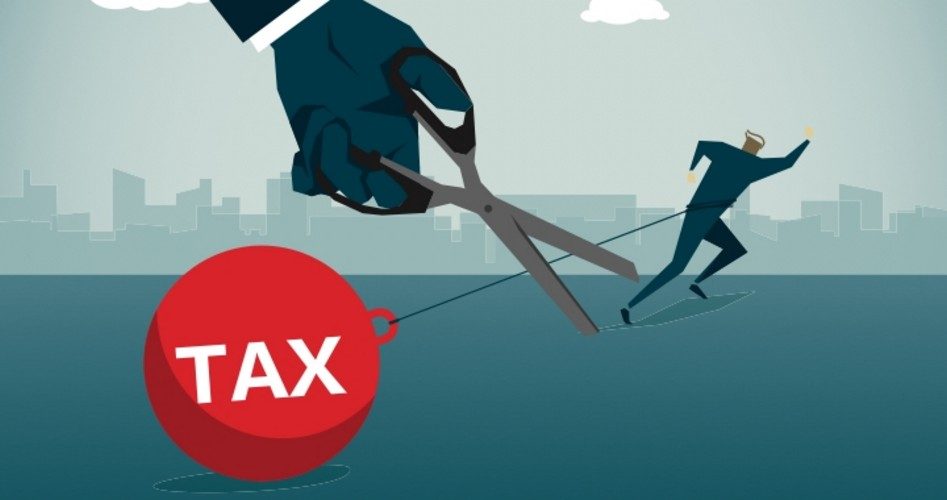
Tax Freedom Day, which “represents how long Americans as a whole have to work in order to pay the nation’s tax burden,” falls this year on April 19 according to the Tax Foundation.
With Americans focused on paying their income taxes by April 17, this year’s deadline, the release from the Tax Foundation last week likely gives them little comfort. The average American worker will have to work until April 19 — 109 days — to pay all of his taxes: federal, state, local and municipal. That’s just three days fewer than last year, thanks to Trump’s tax reform law. Put another way, the total tax bill of $5.2 trillion soaks up more than a quarter of the economy’s total gross annual output.
According to the foundation, that’s more than the average American spends on food, clothing, and housing combined. The foundation counts every conceivable tax to come up with its conclusion: individual income taxes (44 days), payroll taxes (26 days), sales and excise taxes (15 days), corporate income taxes (seven days), and property taxes (11 days). The balance comes from estate and inheritance taxes, customs, duties and other taxes.
Not wanting to leave any potential future tax bill uncounted, the Tax Foundation added how long it would take the average American taxpayer to pay for the money the federal government borrowed this year. After all, those borrowings, says the foundation, are simply taxes that haven’t been paid yet. With the federal deficit pushing a trillion dollars a year, this calculation extends Tax Freedom Day from April 19 out to May 6, 17 days later.
Averages, of course, are deceiving. For instance, New York residents “celebrate” their Tax Freedom Day on May 14th, the longest of any state.
Other states’ rankings reflect their relative tax laws. For instance, Illinois residents’ Tax Freedom Day comes on April 29, while Connecticut’s and New Jersey’s residents enjoy starting to work for themselves after May 4. Residents of Louisiana join Alaska’s with the lowest annual tax burden in 2018: their Tax Freedom Day arrived on April 4. They were followed by taxpayers in Tennessee, Oklahoma, and Alabama who enjoyed the opportunity to start working for themselves after April 5.
Those taxpayers who dream of “the good old days” — i.e., before the income tax was authorized by the 16th Amendment in 1913 — will likely be astonished to learn when Tax Freedom Day occurred when the government funded itself adequately without income taxes. In 1900, Americans enjoyed Tax Freedom Day on January 22.
The Supreme Court is likely to force the Tax Foundation to do a reset for next year. On Tuesday the Supremes will start hearing arguments in South Dakota v. Wayfair, Inc., the online retailer. The state wants to levy sales taxes on all of Wayfair’s customers, not just those living in South Dakota. Wayfair is contesting the tax on the basis of a 1992 Supreme Court ruling that holds that no state could collect sales taxes from any retail customer buying over the Internet unless the seller had a physical presence in the state.
South Dakota is making the case that this precedent should be discarded, applying an “economic presence” instead. Tax and legal experts are predicting that the Supremes will agree with South Dakota when it rules on the matter in June. Joseph Bishop-Henchman, executive vice president of the Tax Foundation, thinks the court will throw out the old Quill ruling, 5-4, or 6-3. As he explained:
South Dakota passed a law requiring internet sellers to collect the state’s sales tax when they sell to South Dakota residents….
The lower court struck down the law as violating the Quill decision. In January, the Supreme Court agreed to hear the case, their first sales tax authority case since 1992. Fifteen briefs have been filed in support of South Dakota, including by the United States government. Twenty-three briefs have been filed in support of Wayfair.
At stake is an enormous potential tax bill. According to FactSet, the gross sales through the internet last year totaled more than $300 billion which, if subject to state sales taxes (45 states levy sales taxes), would cost consumers between $4 billion and $6 billion a year. Add that onto the Tax Foundation’s present estimate, and American taxpayers won’t be done supporting all levels of government until well into the month of May.
Governments’ voracious appetite for revenues at all levels continues to turn Americans into tax slaves for more than four months every year.
Photo: erhui1979/DigitalVision Vectors/Getty Images
An Ivy League graduate and former investment advisor, Bob is a regular contributor to The New American magazine and blogs frequently at LightFromTheRight.com, primarily on economics and politics. He can be reached at [email protected].



